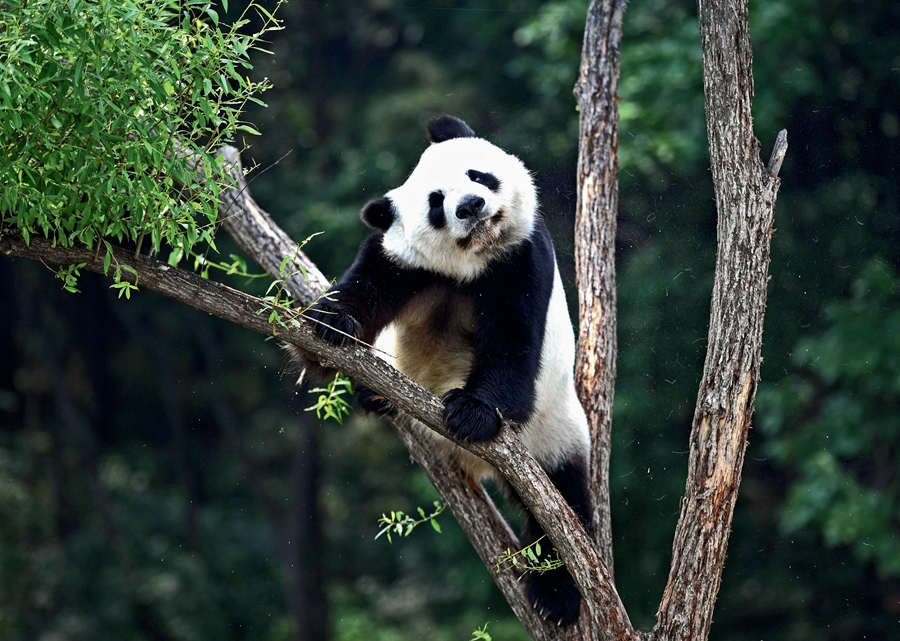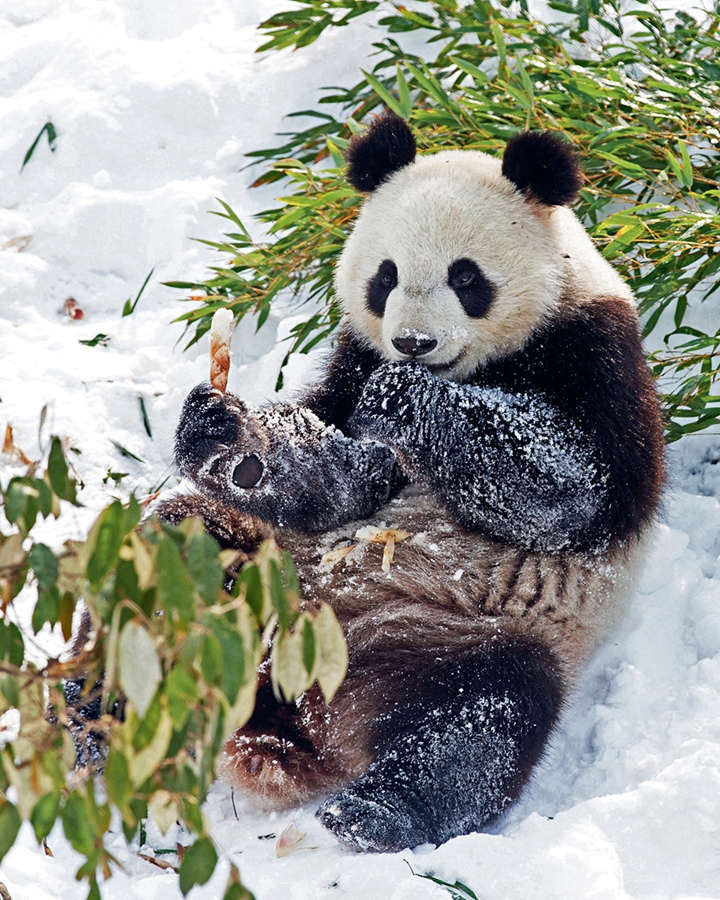By JIANG FUMEI
THE panda is an ancient inhabitant of the earth. As early as eight million years ago, its ancestor began to live in the territory that now lies in China. Today, pandas, which mainly inhabit the mountainous regions of Sichuan, Shaanxi and Gansu provinces, have not only become China’s national treasure, but are also widely loved by people of the world. In 1961, the panda became the mascot of the World Wildlife Fund.
Inhabiting deep mountains and forests, its black and white appearance is conducive to its hiding in the foliage and snow-covered ground to avoid being discovered by natural enemies. In addition to black limbs, ears, nose and tail, its eyes are surrounded by a circle of black hair, the area from chest to shoulder and the neck is also surrounded by a circle of black hair, and other parts are all white. However, there are exceptions; some of them have black abdomens, while others are white. In addition, due to factors such as sunshine and nutrition, some pandas are not pure enough in color, may be reddish, grayish, or brownish.

Pandas belong to the family of bears which are predatory mammals. However, pandas consume various kinds of bamboo as their primary diet, and they also eat weeds, flowers and vines. Their molars and masseter muscles are particularly developed, so they have strong chewing ability. Unlike general carnivores, pandas are more similar to herbivores. Pandas also retain the shorter intestines of carnivores; they do not have complex digestion and huge caecum that herbivores have for storing food. There is also no symbiotic bacteria or enzymes in their intestines and stomach that break down cellulose into absorbent nutrients. The only way to get the nutrition they need is to eat more, so pandas eat more than half the time each day.
Pandas are not completely vegetarian. Instead, they look for and catch bamboo rats hidden in bamboo groves, and love honey just as other bears do. They are also known to go after goats and will also consume ox meat if they come across a carcass.
The seemingly clumsy pandas are not slow runners, when encountering danger they can run as fast as the best athletes in the world. However, pandas often prefer to climb tall trees in times of danger. Its front paw not only has five toes, but also evolved a modified sesamoid bone – which not only helps it to grasp bamboo, but also makes it easy to climb.
The pandas also have a thick layer of skin under the fluffy exterior that allows them to adapt to the cold and humid climate of the mountains. When winter comes, instead of starting hibernation, pandas retreat from the mountainside into the relatively warm valleys. Even in winter there are still fresh bamboo leaves in the mountains it dwells in. In spring, there will be bamboo shoots, which the pandas are really fond of.
However, due to a majority of life spent in dark woods, pandas are short sighted, and for this reason possess a bit of clumsiness that has created that perception of them seen as cute.
Playing in the snow.
An adult panda is about 160-180 cm in length and about 80-120 kg in weight. The physiques of male pandas are better developed than female ones, and the man-fed ones are larger than those found in the wild. As solitary animals, wild adult pandas mark their territory by the smearing of body fluids in their territory. From March to May of each year, female pandas enter mating season, and male pandas receive the signal to begin courtship. Pandas do not mate for life and choose different mates.
About half of female pandas can bear babies in a mating season, some of which are twins or even triplets. However, female pandas need to undertake pregnancy, childbirth and feeding alone. Without human help, the panda mother can only nurture the strongest one and give up the weaker ones. In order to produce and feed their children, the wild female panda looks for a warm tree hole and fill it with thick hay to welcome her newborn.
A Panda’s pregnancy lasts for eight months. Newborn pandas are as small as mice, with an average weight of 120 grams and the smallest only 50 grams. With sparse white hair, they cannot open eyes, but do make loud cries. After about two weeks, as the hair grows, the part of black hairs grows darker in color. Within a month, their ears, eyes, legs and shoulders all grow black furs slowly. About six to eight weeks old, cubs open their eyes and begin to grow teeth. Three months later, they can crawl slowly.
Around the age of 18 months, the cub gains the ability to leave its mother’s care and fend for itself. Prior to that, it is taught to seek shelter and food, eat, climb trees and swim. By the age of six, the panda begins courtship. For pandas bred in captivity, courting and breeding start at the age of four due to more conducive conditions.
Their ancestors, who lived eight million years ago on Chinese territory, were only about half the size of modern pandas. However, seen from their fossil teeth, their eating habits may be similar to today’s offspring. A million years ago, their ancestors once thrived. Panda remains are found in most parts of eastern and southern China, and even in southern Myanmar and northern Vietnam.
By the time of the Western Jin Dynasty (265-316), people started to regard panda as a symbol of peace. During wartime, if one side raised a flag with panda pattern, they hoped that active fighting would be suspended and peace could follow. Since then panda has become a messenger of peace and friendliness. According to Japanese historical records, Empress Wu Zetian (624-705) of the Tang Dynasty gave the Emperor of Japan a pair of living pandas.
It was not until the 19th century that pandas were introduced to the West. In 1869, a French missionary Armand David discovered what the locals call the striped bear in Baoxing, Sichuan Province, and shipped a specimen to Paris, France, The new species was named Ailuropoda melanoleuca. Since then, the panda has attracted the attention of explorers and adventurers in Europe and the United States. A batch of explorers including the sons of President Roosevelt came to the mountains in southwestern China to seek out pandas. In 1936, a U.S. fashion designer received a sensational welcome when smuggling into his country a three-month-old panda from Wenchuan County, Sichuan Province. Within 10 years, more than 20 pandas were smuggled into Europe and the U.S., but all failed to leave descendants. The number of poached specimens was no less than 100.
Since its founding, the People’s Republic of China has made the protection of giant pandas an important task. In the 1960s, panda was named a protected animal, and Wolong and other four panda nature reserves were established. In the 1970s, the first national panda census was conducted and the number of nature reserves for pandas was extended to 13. Into the 1990s, the national panda reserve increased to 36.
Since the beginning of the new century, China has returned cultivated lands to forests in many regions, and resettled local residents. Nowadays, there are 63 nature reserves in China that are dedicated to the protection of pandas. The national panda habitats have been increased from 22,000 square kilometers in the 1980s to 34,000 square kilometers. The number of wild pandas has increased from 1,300 to about 2,000. In 2016, the International Union for Conservation of Nature adjusted the protection level of panda from endangered to vulnerable.
JIANG FUMEI is a free-lance writer.

